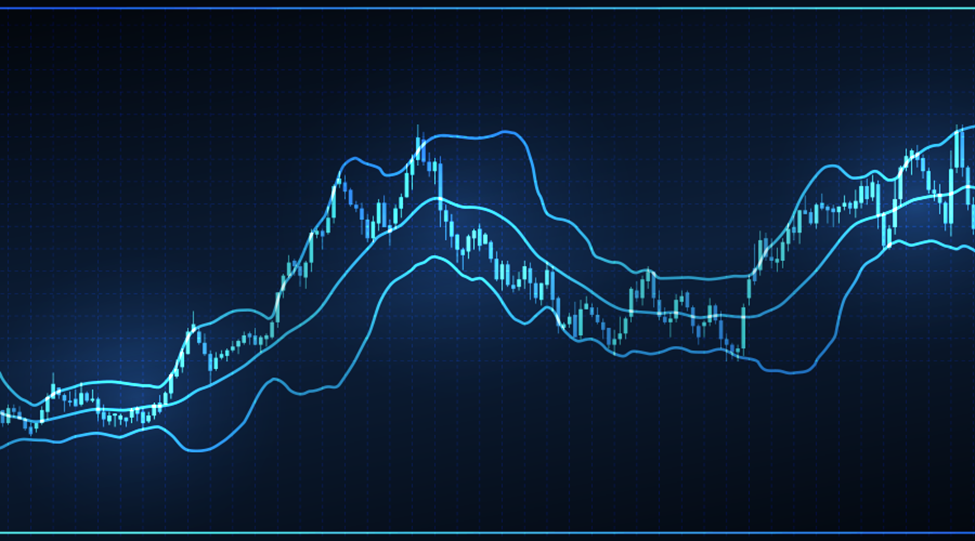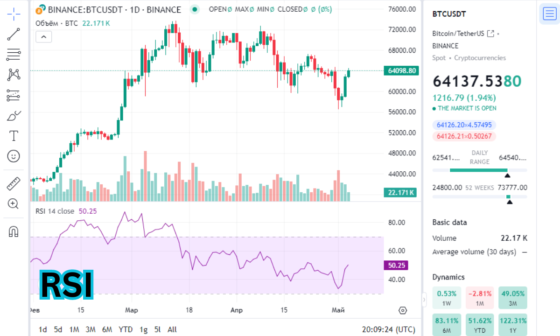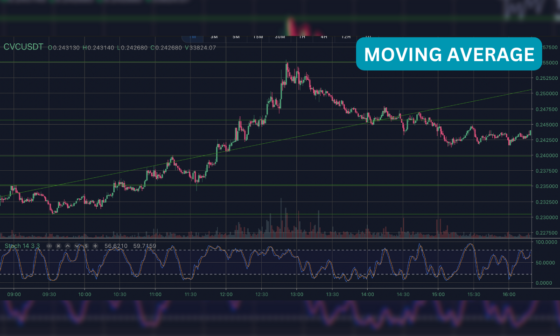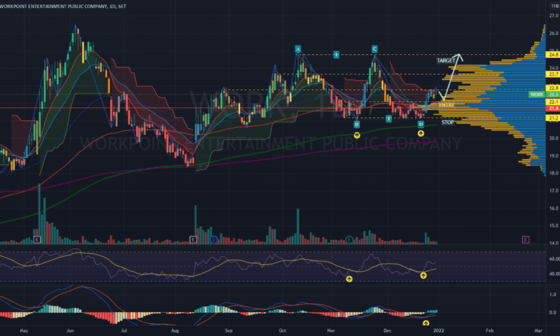Understanding Simple moving average (SMA)
It’s no secret that moving averages are key for all traders. But there’s more to this versatile indicator than most people realize.
In this post, we’ll take a close look at the simple moving average – or SMA – and explore how you can use it to your advantage in the markets. We’ll also discuss some of the pros and cons of using this type of moving average, so you can decide if it’s a good fit for your trading style. Finally, we’ll look at a few examples to help illustrate how this indicator works in practice. So whether you’re just getting started in the markets or you’re looking for a new way to improve your trading results, be sure to read on!
What is the Simple Moving Average?
A simple moving average or SMA is an average calculation for asset prices over a specified time period. It combines past closing prices for the specified period divided by a number of data points for the specified period.
SMA is a key indicator in technical analyses and mainly is the easiest moving average in construction. Technical analysts and day traders follow the SMA movement because it shows the forex pairs, crypto pairs, or stock prices trend or support
resistance levels.
All MAs are meant in this context to indicate how prices are shifting relative to past prices.
SMAs are constructed using past closed prices, which also indicate lags. It just reflects an earlier price movement trend and does not mean it can predict prices.
How it’s calculated?
The SMA calculation consists of dividing the price of an asset into several periods and then dividing it by a number of time periods. The SMA of the past 10 days is the average closing price for 10 days. It is calculated by taking the sum of closing prices for each day divided by 10.
For instance: Let’s say Apple’s closing prices for the 10 days period have been $56.5, $55.6, $53.9, $55.0, $56.0, $58.5, $60.2, $59.8, $60.8, $61.2. The average of the closing prices would be ($56.5 + $55.6 + $53.9 + $55.0 + $56.0 + $58.5 + $60.2 + $59.8 + $60.8 + $61.2)
10 This 10 represents the period’s day number. The average is recalculated as new statistics arrive and thus the average is moved to the next level.
How are simple moving averages used in technical analysis?
Traders can utilize Simple Moving Averages (SMAs). This enables trader comparison of the short and long-run trends for a longer period. Typically this is considered a bearish death cross pattern and a sign of a continued decline. The reverse pattern, namely the golden cross, indicates possible markets rallying.
The simple moving average is a technique used in technical analysis to help smooth out the data and make it easier to identify trends. The simple moving average is calculated by taking the average price of a stock over a certain period of time, usually 20 days. The advantage of using a simple moving average is that it is easy to calculate and interpret. Moving averages are used in a variety of ways, but one common use is to identify support and resistance levels. For example, if the 50-day moving average is below the 200-day moving average, this is often seen as a sign of weakness in the stock, and traders may look for opportunities to sell. Conversely, if the 50-day moving average is above the 200-day moving average, this may be seen as a sign of strength in the stock, and traders may look for opportunities to buy. either level, traders may look for opportunities to mean-revert back to the other moving average. Moving averages can be used in conjunction with other technical indicators to form a complete trading strategy. For example, a trader may use the 50- and 200-day moving averages as support and resistance levels and use candlestick patterns or oscillators to time their entries and exits. No matter how you use them, simple moving averages are an essential tool for any technical trader.
Buying and selling on SMA and asset price crossovers
Technical traders frequently use SMAs for timing their buying or selling trades. They analyze when asset prices intersect with SMAs.
We consider Amazon’s example for a 10-day SMA. When the stock closing price is over the moving average line, usually the stock price constantly rises. It has been used by technical traders frequently to indicate buying. But once stock prices cross and fall below the SMAs line, there will continue a downward trend for another bit. This can be an indication of selling.
Entry opportunities based on longterm SMA and short term SMA crossover
Another method of using SMAs to generate entry trade signals is based on 2 SMAs crossovers. Because SMA smoothes out price fluctuations direction shows asset price trends. Using this feature of SMAs you can go long when short term SMA crosses above long term SMA and vice versa you can go short when short term SMA crosses below long term SMA.
Identifying support and resistance levels with SMAs
MAs also help identify support and resistance levels for stock prices. The resistance level is the price at which selling is thought to be strong enough to prevent the stock from rising further. The support level is the price at which buying is thought to be strong enough to prevent the stock from falling further.
Stock prices often rebound from support and resistance levels. So, when the stock price hits a support level, it is thought to be a good time to buy. When the stock price hits a resistance level, it is thought to be a good time to sell.
When the stock price is trading above the 200-day SMA, it is considered to be in an uptrend. This means that the stock The resistance will not lower and resistance will likely be at a level it will not breach.
The stock price will break out of the trend after the stock stays above the MA for a long period before breaking out of the trend. Breakouts can often serve to trigger trade decisions.
200 – day simple moving average and markets long term trends
The 200-day simple moving average is one of the most popular technical indicators. It is used by chartists to identify long term trends and market cycles. When the stock market is above the 200-day SMA, it is in an uptrend. This means that the stock market has been rising for at least 200 days. When the stock market is below the 200-day SMA, it is in a downtrend. This means that the stock market has been falling for at least 200 days. The 200-day SMA is a very popular technical indicator because it is easy to understand.
Note
When stock prices drop below the 200 SMA, it generally signifies a possible recession has occurred.
Many investors use the alert either for a hedge fund or for a complete sale.
Simple Moving Average vs Exponential Moving Average
There are many types of moving averages. The most popular ones are simple moving averages and exponential moving averages. While both are lagging indicators, meaning they follow the trend, the major difference between them is the exponential moving average (EMA) gives more weight to recent price action, while the simple moving average (SMA) applies an equal weight to all prices.
The exponential moving average is simply an exponentially weighted moving average.
The exponential moving averages are therefore more responsive to recent price changes than the SMAs. The SMA lags behind because it is an average of past prices and takes into account recent prices less than the exponential moving average.
Simple Moving Average vs. weighted Moving Average
The weighted moving average is the linearly weighted average of asset closing prices.
The weighted moving averages (WMA) are similar to the simple moving average, except that it gives more weight to recent prices. The WMA is therefore more responsive to recent price changes than the SMA.
Meanwhile, EMA is more responsive to recent price changes than weighted MA, because it is an exponentially weighted average of asset closing prices.
How to use SMA in your trading strategy
As a trader, one of the most important things you can do is to develop a moving average (MA) trading strategy. A moving average is simply the average price of a stock or other asset over a given period of time. By looking at the moving average, you can get a sense of the overall trend of the market and make decisions accordingly.
There are a number of different ways to use moving averages in your trading strategies. One popular approach is to buy when the stock price moves above the MA, and sell when it moves below. Another common way to use moving averages is to look for crossovers, which occur when the MA of one stock crosses above or below the MA of another. These crossovers can be used as signals to buy or sell.
Moving averages can also be helpful in identifying support and resistance levels. If the stock price is consistently bouncing off the MA, it may indicate that there is significant support at that level. Similarly, if the stock price is regularly trending downward toward the MA, it may be an indication that there is significant resistance at that level.
There are endless ways to incorporate MAs into your trading strategy. The key is to experiment and find what works best for you. With a little practice, you can use MAs to give yourself an edge in the market and start seeing success in your trades.
Tips for improving your success with SMA
SMA, or simple moving average, is a widely used technical indicator in forex and crypto trading. SMAs smooth out price action by averaging out previous prices, making it easier to identify trend direction. There are many different ways to use SMAs to improve your success as a trader.
One example is to use shorter period SMAs (e.g. 10-period, 20-period) to identify potential turning points in the market. As prices move up or down, they will eventually start to cross the SMA, which can signal a change in trend direction. By paying attention to these crossover points, you can get an early indication of where the market is headed and adjust your trading accordingly.
Another way to use SMAs is by watching for price action around the SMA itself. If prices are consistently bouncing off the SMA, it could be an indication that it is acting as support or resistance. In this case, you would want to look for opportunities to enter trades in the direction of the bounce.
By incorporating SMA into your trading strategy, you can add another layer of analysis and increase your chances of success. Remember that no indicator is perfect, so always use it in conjunction with other technical and fundamental indicators before making any trading decisions.
Limitations of simple moving average
While the SMA can be a helpful tool, it is important to keep in mind that it has its limitations. One of the biggest drawbacks is that it is a lagging indicator, which means that it can take some time for the SMA to catch up to price changes. In addition, because the SMA is based on past prices, it doesn’t necessarily provide any insights into future price movements. As a result, many traders also use other indicators in conjunction with the SMA to get a more complete picture of what might happen next.
Conclusion
The SMA is a versatile moving average that can be used in a number of different ways to help you find success in the markets. By understanding how this indicator works and what some of the pros and cons are, you can start using it to your advantage today. And if you’re looking for even more help incorporating MAs into your trading strategy, be sure to subscribe to our free SMA based basic intraday strategies. With these valuable resources at your disposal, you’ll be well on your way to becoming a successful trader in no time!







